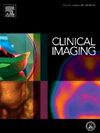Management of renal cell carcinoma with ablation in comparison to nephrectomy: A 5-year analysis of inpatient procedural data to evaluate utilization disparities in the United States
IF 1.8
4区 医学
Q3 RADIOLOGY, NUCLEAR MEDICINE & MEDICAL IMAGING
引用次数: 0
Abstract
Purpose
To perform a nationwide analysis of ablation compared to partial and total nephrectomy for the management of renal cell carcinoma (RCC) to evaluate utilization trends and disparities in the USA.
Materials and methods
The 2016–2020 National Inpatient Sample was analyzed. Using ICD-10, we identified the diagnosis of RCC then analyzed the utilization trends of ablation and nephrectomies (both partial and complete). To determine if any disparities exist, a multivariate logistic regression was performed to assess the influence of age, sex, race, income, payer, illness severity, geographical location, and hospital factors.
Results
From the 183,885 inpatient encounters with RCC, 3045 (1.65 %) underwent ablation, 70,080 (38.1 %) underwent partial nephrectomy, and 110,760 (60.2 %) underwent total nephrectomy. There was no significant difference in the sex between all groups. There was a statistically significant difference in the mean age of those undergoing ablation (67.30, SD = 12.05) versus those undergoing partial nephrectomy (59.27, SD = 13.26) and total nephrectomy (62.22, SD = 14.42) (OR: 1.04, 95%CI: 1.03–1.05, P < 0.001). Compared to White patients, Hispanic and African Americans were more likely to undergo ablation versus nephrectomy (OR: 1.52, 95%CI: 1.16–1.98, P = 0.002 and OR: 1.65, 95%CI: 1.28–2.13, P < 0.001, respectively). Compared to patients on private insurance, those on Medicaid and Medicare were more likely to have ablation than nephrectomy (OR: 1.85, 95%CI: 1.31–2.61, P < 0.001, and OR: 1.62, 95%CI: 1.26–2.08, P < 0.001, respectively). Furthermore, patients were less likely to undergo ablation than nephrectomies in 2020 compared to 2016 (OR: 0.69, 95%CI: 0.53–0.90, P = 0.006).
Conclusion
Since 2016, there has been a decreasing trend in the use of ablation for treating RCC in hospitalized patients. Those undergoing ablation tend to be older, African American, Hispanic, and insured by Medicare or Medicaid. Further research is needed to ensure equitable access for optimal treatment of RCC.
求助全文
约1分钟内获得全文
求助全文
来源期刊

Clinical Imaging
医学-核医学
CiteScore
4.60
自引率
0.00%
发文量
265
审稿时长
35 days
期刊介绍:
The mission of Clinical Imaging is to publish, in a timely manner, the very best radiology research from the United States and around the world with special attention to the impact of medical imaging on patient care. The journal''s publications cover all imaging modalities, radiology issues related to patients, policy and practice improvements, and clinically-oriented imaging physics and informatics. The journal is a valuable resource for practicing radiologists, radiologists-in-training and other clinicians with an interest in imaging. Papers are carefully peer-reviewed and selected by our experienced subject editors who are leading experts spanning the range of imaging sub-specialties, which include:
-Body Imaging-
Breast Imaging-
Cardiothoracic Imaging-
Imaging Physics and Informatics-
Molecular Imaging and Nuclear Medicine-
Musculoskeletal and Emergency Imaging-
Neuroradiology-
Practice, Policy & Education-
Pediatric Imaging-
Vascular and Interventional Radiology
 求助内容:
求助内容: 应助结果提醒方式:
应助结果提醒方式:


